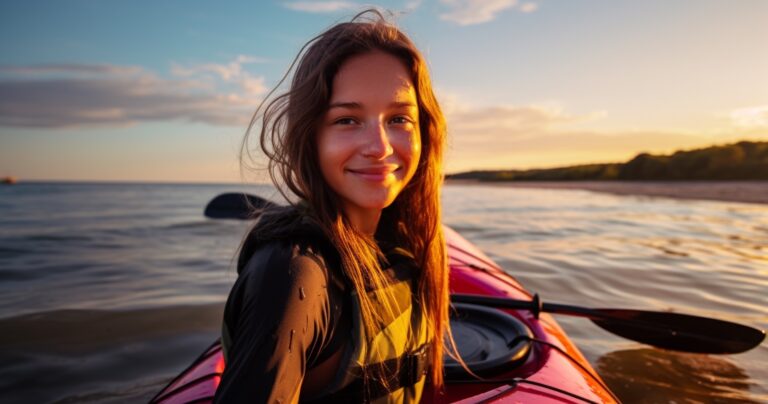Kayaking vs. Canoeing
Introduction to Water Adventures
Water sports have always been a source of thrill and excitement. They not only offer an adrenaline rush but also provide a unique way to explore nature’s beauty. Among the various water sports, kayaking and canoeing stand out due to their popularity and accessibility. Whether you’re navigating through calm lakes or challenging whitewater rapids, these activities offer unforgettable experiences. But how do you decide which one is right for you? Kayaking vs. canoeing – Let’s dive in!
Key Takeaways
| Kayaking | Canoeing |
|---|---|
| Faster and more agile | Slower and more stable |
| Lower to the water, enclosed cockpit | Higher off the water, open cockpit |
| Uses a double-bladed paddle | Uses a single-bladed paddle |
| Ideal for rough waters | Ideal for calm waters and carrying more gear |
| Better for sea adventures and whitewater rapids | Better for leisurely trips and camping expeditions |
Understanding Kayaking
Kayaking traces its roots back to the Inuit people who used these versatile boats for hunting and fishing. Modern kayaks, while much evolved, continue to offer that sense of adventure and closeness to nature.
Types of Kayaks
There are several types of kayaks designed for different water conditions:
- Recreational Kayaks: These are stable, easy to steer, and perfect for beginners. They’re best suited for calm waters like lakes and slow-moving rivers.
- Touring Kayaks: These are designed for longer journeys on open waters like seas or large lakes.
- Whitewater Kayaks: These are smaller, robust, and highly maneuverable, designed specifically for navigating through rapid waters.
Skills Required
Kayaking requires a certain level of physical fitness as it involves the use of upper body strength. Key skills include paddling techniques, navigation skills, and the ability to perform an “Eskimo roll” in case the kayak capsizes.
The Kayaking Experience
Kayaking offers an immersive water experience. Being low on the water surface and in an enclosed cockpit, you feel a part of the water body you’re navigating.
Physical Demands
Kayaking can be physically demanding, especially in rough waters. It requires good upper body strength, core stability, and balance. However, it also offers a great way to improve your fitness level.
Typical Locations
Kayakers can explore a variety of locations ranging from calm lakes and rivers to sea coasts and whitewater rapids. Each location offers a unique set of challenges and experiences.
Potential Challenges
While kayaking is fun, it does come with its set of challenges. These include dealing with changing weather conditions, navigating through difficult waters, and ensuring safety measures.
Understanding Canoeing
Canoeing is an ancient mode of transportation that has turned into a popular recreational activity. It offers a relaxed pace that’s perfect for enjoying scenic views or going on camping trips.
Types of Canoes
Canoes come in various designs catering to different needs:
- Recreational Canoes: These are wide and stable, ideal for families or beginners.
- Expedition Canoes: These are long and sturdy, designed for long trips carrying heavy loads.
- Whitewater Canoes: These are compact and robust with high sides to handle rapid waters.
Skills Required
Canoeing requires less physical strength compared to kayaking but demands good teamwork if it’s a tandem canoe. Key skills include paddle strokes, steering techniques, and communication if canoeing with a partner.
The Canoeing Experience
Canoeing offers a serene experience. Being higher off the water in an open boat gives you a great vantage point to enjoy your surroundings.
Physical Demands
While canoeing is less physically demanding than kayaking, it still provides a good workout. It involves the use of both upper body strength and lower body stability.
Typical Locations
Canoes are perfect for calm waters like lakes or slow-moving rivers where you can enjoy the scenery or go fishing.
Potential Challenges
Just like any water sport, canoeing comes with its own set of challenges. These include maintaining balance in the canoe, steering correctly, dealing with wind conditions, and ensuring safety precautions.
Kayaking vs Canoeing: A Comparative Analysis
When comparing kayaking and canoeing, several factors come into play. Here’s a comparative table to help you understand the differences:
| Aspect | Kayaking | Canoeing |
|---|---|---|
| Speed | Faster due to streamlined design | Slower due to wider design |
| Stability | Less stable due to lower profile | More stable due to wider base |
| Maneuverability | High maneuverability, especially in rough waters | Less maneuverable but tracks well in a straight line |
| Capacity | Limited capacity, ideal for solo or tandem paddling | Higher capacity, can carry more gear or passengers |
| Suitability | Ideal for sea adventures and whitewater rapids | Ideal for leisurely trips, fishing, and camping expeditions |
Choosing Your Water Adventure: Factors to Consider
Choosing between kayaking vs. canoeing depends on various factors. Here are some things to consider:
- Personal Preference: Do you prefer a fast-paced adventure or a leisurely trip?
- Physical Fitness: Kayaking requires more upper body strength while canoeing requires balance and coordination.
- Adventure Goals: If you’re looking for thrill and speed, kayaking might be your choice. For a relaxed pace and the ability to carry more gear, canoeing could be better.
- Safety Considerations: Both sports require safety measures like wearing life jackets and knowing how to swim.
Conclusion: Embracing the Waves
Whether you choose kayaking or canoeing, both offer unique experiences and adventures. It’s all about finding the one that suits your interests, capabilities, and spirit of adventure. So why wait? Embrace the waves and start your water adventure today!
